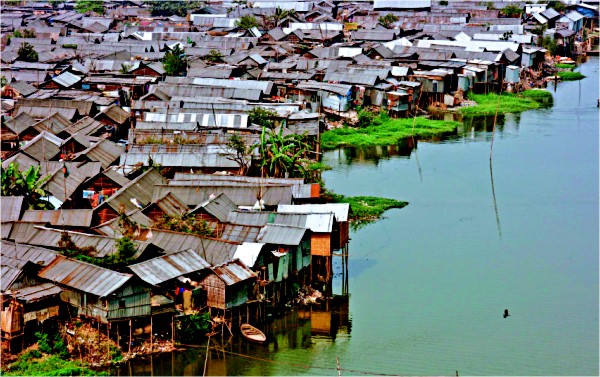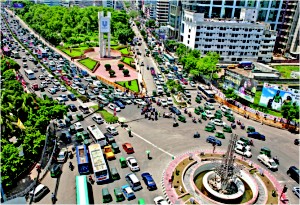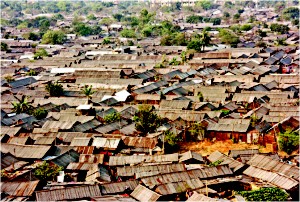

Photo: Wahid Adnan/Driknews
Towards a liveable Dhaka
Dr. Zebun Nasreen Ahmed
Dhaka, it may be argued, is gradually, but surely, becoming unliveable. As an architect, I feel there is a lot that can be done towards rectifying the situation, and thus, saving Dhaka from the brink of disaster. This piece is a reflection of steps that are still possible steps that can salvage us from the edge of a precipice that can only spell extinction. The discussion begins with a short overview of the density situation, and approaches to this problem that is being taken in Hong Kong. But Dhaka too has its positives, which is discussed in a section on our strengths, including among other points, density, non-motorised vehicular options, lower expectations, hardier populations, etc. The piece is rounded off with some suggestions that can lead towards a sustainable solution.
Dhaka - the density problem
In recent years the major problems in Dhaka are innumerable. I do not pretend to know the solutions of many of them in this discussion I merely attempt to concentrate on the architectural / planning issues that concern the designer of the physical and environmental aspects of the city.
Undoubtedly we are a very dense city with a population varying according to which city limits are being referred to. And which ever figure we quote, the crux of the matter is that our density is extremely high one of the highest in the World. However, in many studies of the recent past, high densities are being encouraged. The compact city concept is gaining acceptance and, even in some cases, preference. For example, the high-density urban environment of Hong Kong is characterised by mixed land uses and housing, an efficient mass transit system and cheap public transport, and easy access to most facilities. Despite the intense density of as many as 54,030 persons/km2 in Kwung Tong and 116,000 persons/km2 in Mongkok, the city copes by the economic use of land through vertical space utilization and short journeys-to-work. With a viable public transport system, only a few roads are needed.
A high level of accessiblity to the various functions of urban life is acheived by reducing the physical separation of activities, a need that originated due to its topography. This is much like Dhaka's growth, stemmed and limited to a north-south extension by its riverine borders. So in spite of the fact that only about 17% of the total land area of 1096 km2 that Hong Kong possesses, can be used because of the terrain, the city works because of the steps it has taken to bring facilities to the people. About 90% of its population depends on the public mass transit railway, which serves as a pollution free, efficient network of connection, while the high-density development produces opportunity. The locations of activities and dwellings are close to each other both horizontally and vertically.
 |
Photo: Wahid Adnan/driknews |
Compact cities
Conceptually, in compact cities, according to advocates, sustainability can be achieved by the following features:
a. High density areas of residential population to reduce sprawl.
b. Space extensive land-uses beyond these residential areas
c. Mixed land-uses to bring facilities closer and ensure that areas do not become dead during slack hours
d. Pedestrian oriented movement system within walking distance of the public and commercial facilities, which would be located along axes with public transport.
Sadly, though Dhaka matches the figures required for 'compact' cities in terms of its density, yet problems are apparent in each of the points noted above. High density areas alone do not make compact cities. In Dhaka, the old city has density figures that far outnumber any other city of the World. But if the needs of the population have to be met through extensive transportation, the compactness becomes a curse, rather than a relief. As the areas in Old Dhaka do not boast up-to-date facilities for schooling, health or commercial purposes, the respective members of the population require to journey to distant locations in other parts of the city to meet these requirements, without resort to any mentionable public transportation system, putting substantial pressures on the circulation systems of the city.
Mixed land-uses are a pre-requisite for compact cities, where other than heavy industrial and hazardous uses, the other uses are located within close proximity to each other. The quality of mixing uses that was a feature of Old Dhaka has slowly but surely been wiped out of modern day Dhaka. Mixed use zoning would ensure that city areas are in use at all hours of the day and night and that dead areas are not formed, like Motijheel or Dilkhusha Commercial Area after 7 pm or during weekends. Mixed use would increase safety of the cities as well as diffuse the population more effectively, thereby decreasing pressures in key locations of the city.
Properly laid out public transportation systems would form the backbone of any compact city, dispersing major sections of the population to their destination through planned routes, minimizing concentrations and disturbances on the road network of the city. There being no such system in Dhaka, the population has to depend on a variety of alternatives to journey to distant but necessary destinations scattered around the city.
Our strengths
The discussions thus far have focused on things that are not working in Dhaka. But we must also try to identify whether there are any positives in our city. I consider the following our plus points.
Density, surprisingly, is considered a plus point if one can house people within minimum space, utilities and services can be optimized. This also leaves the option of open spaces which would otherwise have been occupied by the needs of sprawling settlements.
Non-motorised transport, the rickshaw, is a sustainable form of transport, which can be used for short distances without impacting on environmental concerns. It also forms a means of living and employment. The routes though need to be carefully planned so that the mix of fast-moving vehicular traffic can be segregated from the slow-moving non-motorised traffic for energy efficiency and safety.
Some characteristics of our population can be considered our strengths. Prime among these is the fact that our population in general has lower expectations in comparison with populations of the more industrialized countries. Thus, it is easier to satisfy people in Dhaka and facilities do not have to be highly refined. In addition, the population in general is hard working, being used to agricultural work or labour-intensive jobs like rickshaw pulling.
It is through our strengths that we should look for solutions to our problems, rather than by merely imitating conditions of the West, or of the more advanced nations. Remembering that the West is often trying to look for solutions that hark back to nature, we, who already have much going for ourselves, need to look inwards to recognize our strengths, so that these can be used along with the more technical/scientific means of the West, to improve our situation.
Solutions
Even without excessive infrastructure development, there are some simple steps that can be taken with immediate effect to alleviate the pain and suffering that Dhaka's population is facing in daily life. Increasing accessibility by encouraging mixed-uses is the obvious options. The main problems discussed here deal with the traffic situation found in the areas. The load varies with peak travel times. Significant jams are created due to school and office timings. Means of alleviation are:
 |
Photo: Wahid Adnan/Driknews |
For Schools and Education
1. Schools must cater for the immediate neighbourhood. The education ministry needs to look into this to ensure that each catchment area has adequate schooling for the immediate population to walk to the facilities. Parents will be skeptical of this, but such is the norm in the developed countries and if at the present time Dhaka does not have the facilities, the need will no doubt pressurize the system to come up with good schools. Walking to school would be the main mode of travel to school. this would not only reduce pollution, save on energy, but would also improve the overall health of the population.
2. For the present, schools have to arrange for school buses. Private cars are to be discouraged, by making the financial returns considerably more lucrative for bus using students, possibly by subsidizing bus usage.
3. School timings can be staggered for different schools (from 7:30 to 9:00 am for the start of school and 1:00 to 2:30 in the afternoon for schools to end) so that peak pressure is distributed and thus diluted.
4. Dispense with extra coaching. Coaching centres create their own sets of problems. The need for coaching centres in the first place is questionable. The developed countries find no need for them, yet it is almost indispensable in the system of education here in Bangladesh. It seems unethical that a teacher appointed by a School for the task, cannot impart knowledge in a school room adequately, and has to ask his/her students to come to separate coaching classes at extra cost, to impart that same knowledge. The Ministry of Education should take note and action regarding this issue, as should the School Authorities.
For Offices and Daily Activities
1. Another of the causes of traffic jams is the need to travel long distances for daily activities, mainly for work. In this digital age, distances can be cut down by increasing electronic communication, emails and on-line activities. E-banking, e-ticketing, and on-line shopping are already acceptable forms of commercial transactions, all geared to save on transportation times, energy usage while increasing options and available choices.
2. Work spaces should also be brought nearer to residences, requiring in many cases to have mixed zones of city development, rather than the separate zones advocated by the previous generation of planners. Not only would transportation be more efficiently handled in such a case, but this would also make city zones safer as the dead zones of whole blocks of commercial cities would have life throughout the 24-hour cycle.
Lifestyle Changes
1. Much more emphasis needs to be given to non-motorized transportation. Cycle lanes are to be developed alongside roads, bordered by safe walk ways. This will have a positive impact on the health of our citizens, which has seen marked deterioration in recent years due to lack of physical exercise. Studies also show that children become more aware of their surrounds when walking to and from school, a fact that can be used to increase environmental awareness which will ultimately help create responsible citizens.
2. It is important to develop pedestrian-only areas in all zones. The only open-to-sky pedestrian shopping area of Dhaka, the New Market, is regularly being encroached by cars and motorcycles, and is slowly losing its leisurely flavour.
3. Lifestyle changes have to go hand in hand with any attempt we make to improve the physical environment. The culture of energy budgeting, reducing consumption, etc, all contribute to sustainable development. For example, simple measures, like the paperless office, can reduce paper wastage, thus saving on waste generation and energy needed for printing, paper production, etc.
Public transportation systems
1. Mass public transportation systems are a must for long distance and short distance travel. The recent water transport facilities from Dhaka's Rayer Bazar to Sadar Ghat areas has seen negative response due to vested interest groups. But it is a viable system with much potential and needs to be developed. Similarly circular bus routes, with dedicated bus lanes can be planned for the main north-south roads in Dhaka, without much initial investment. If buses run every ten or fifteen minutes during the peak times 7:30 am to 9:30 am and then from 4:30 pm to 6:30 pm, while the frequency is reduced for off-peak hours, the common citizen can benefit substantially. Such a system is already in force in many countries of the world, and it only takes will to develop and maintain. The present system in Dhaka of buses using the entire road and blocking junctions in order to prevent each other from gaining time and passengers is totally unacceptable.
2. Mixing fast and slow moving traffic causes delays and bottlenecks, while being energy inefficient and wasteful. Localizing rickshaws to ply within specific localities, which has been attempted in the past is worth reconsidering. In this system a rickshaw of one locality would only be allowed to cross into an adjoining locality through set cross over points.
3. No system can work without proper law enforcement. Traffic management has to be enforced and monitored and these laws and restrictions should be applicable for the entire 24 hours and not be relaxed on holidays and after 10pm. Slackness and lack of punishment, along with corruption, are main reasons for the lack of traffic discipline on our roads.
Sustainability in our approaches to development will ensure that this city is liveable for a long time to come. Every measure we take must be clearly weighed for its impact on the environment and on the way we are expected to live our lives. Ultimately the situation in Dhaka affects the whole nation. The suggestions I have enumerated here are not confined to any one discipline, but require a concerted effort from many sections of our population. Moreover most of the suggestions do not require intensive fund overlays and are relatively a matter of implementing an attitude change. But time is running out and despite how we may feel, Dhaka can still be saved.
The writer is Professor, Department of Architecture, Bangladesh University of Engineering and Technology.